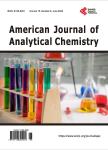Conductivity Method as a New Monitoring Technique for Corrosion and Corrosion Inhibition Processes of Zinc Metal
Conductivity Method as a New Monitoring Technique for Corrosion and Corrosion Inhibition Processes of Zinc Metal作者机构:Department of Chemistry College of Arts and Sciences University of Petra Amman Jordan Department of Basic Sciences American University of Madaba Amman Jordan Department of Chemistry The University of Jordan Amman Jordan
出 版 物:《American Journal of Analytical Chemistry》 (美国分析化学(英文))
年 卷 期:2020年第11卷第10期
页 面:349-361页
学科分类:08[工学] 080502[工学-材料学] 0805[工学-材料科学与工程(可授工学、理学学位)]
主 题:Conductivity Monitoring Technique Corrosion Corrosion Inhibitor Lignosulfonate
摘 要:The electrical conductivity method was successfully applied as a new monitoring technique to monitor the corrosion and corrosion inhibition processes of zinc metal. Measurements of electrical conductivity at 20.0°C of three different corrosive solutions (HCl, NaOH, and NaCl) were performed with two different concentrations (0.10 and 1.00 M) containing zinc sheets in the absence and presence of four different concentrations of sodium lignosulfonate (1.0, 5.0, 10.0, and 20.0 mM). The analysis of curves that illustrates the changes in electrical conductivity of these solutions provides qualitative information about the strength of corrosion as well as the extent of corrosion inhibition behavior. The results obtained from electrical conductivity measurements revealed that sodium lignosulfonate was an effective corrosion inhibitor in acidic medium (for both 0.10 and 1.00 M HCl) in which it converted into lignosulfonic acid, but was less effective in salt and alkaline media.



